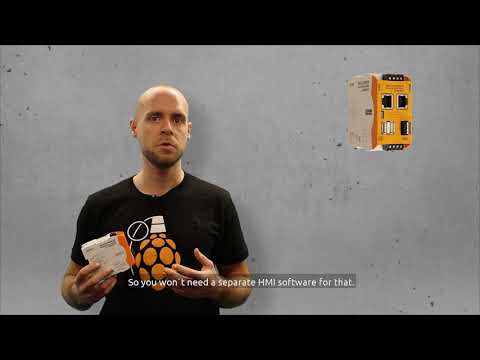The Device Chronicle interviewed Boris Crismancich, Business Development Director, and Ekkehard Krebs, Head of Marketing, at Kunbus GmBH on how the Raspberry Compute Module under the hood of the Revolution Pi is providing huge flexibility and compatibility at low cost in industrial IoT applications.
Kunbus is the producer of the Revolution Pi series. This is a hardware platform used in many IoT installs including one at Stadtwerke Leipzig for distributed energy management. Kunbus brought the Revolution Pi to market in 2016 “at the cusp of the IoT revolution.”
Background to Revolution Pi launch
Boris explains the background: Back then (and this was before Boris joined Kunbus but while still working in the automation industry), he says it was common to go to manufacturers with BI solutions and data analysts, but the problem was that industrial manufacturers had a dearth of data.
These manufacturers needed hardware solutions to be able aggregate data from machines in industrial plants, industrial networks and industrial field bus protocols. Boris and his colleagues started to experiment with the Raspberry Pi automation heads and 5 volts microelectronics world, which did not work that well, there was a project with a railway company. He says “We tried to do industrial IoT, and then we stumbled on the Revolution Pi from Kunbus. It was a revelation and is a Swiss penknife of automation. You can just put a display and keyboard and mouse and use it as an industrial PC. You can add scanners and use it as a PLC and control motors, inputs and outputs, and work with all types of industrial sensors.”
The Revolution Pi (RevPi Connect+) has the added benefit of supporting many modules that can be added together to build powerful things. Boris adds “It is comfortable to have a starting point where the software is compatible with all Raspberry Pi software because all the big cloud providers have examples of their services for Raspberry Pi so you can do these. Some organisations such as Stadtwerke Leipzig put Yocto on the Revolution Pi as they require a more streamlined custom Linux distribution for their applications. There are many others like them who do not use Debian (Raspbian OS).

Based on Raspberry Pi compute module
The Raspberry Pi compute module is used in the Revolution Pi. Boris observes “A standard Raspberry Pi wouldn’t be suitable for industrial applications. Kunbus comes from field bus and industrial network components and is developing and producing products for a global player in automation technology with a strong focus on safety. So the idea was to create a Raspberry Pi industrial-grade PLC that was fully compatible with all the Raspberry Pi applications such as 3D transformations, OPC OA, any transformation of data. There are many software libraries available for all kinds of everything.”
Both Ekkehard and Boris believe that the Revolution Pi is a “game changer” in industrial IoT. The Revolution Pi has great flexibility and can interface with many programming standards and languages. It is also open as there is no proprietary software on the device. Boris says “With the Revolution Pi, you can write Java, C sharp, Python or go the industrial OT route and use Codesys. The Raspberry Pi Compute Module which is at the centre of the Revolution Pi is a mass product and can scale with low prices. It is also more versatile and less expensive than the traditional industrial PLCs.”
Revolution Pi applications and use cases
Where does the Revolution Pi come into use in industrial settings? Boris explains with some examples: an industrial customer needs real time data for production. They want to know which customer’s jobs are running on the machines at any given time? They want to know what the specification of the customer’s job is that needs to be produced? These tasks need a specific connection to the ERP system.
There is also “just in time” production so you need real time data on the production of the providing companies. This moves into the realm of addressing OEE (Overall Equipment Effectiveness). To serve this use case, you need to get data out of the PLCs. Now you are breaking down the wall between IT and OT, Boris explains. He goes to provide background on how industrial OT (operational technology) and IT grew apart: “In the early 80s we could just use computers for switch cabinets, computers were not reliable and complex, instead the OT professionals started to call them industrial controllers and this installed a wall. On one side IT will have billions of lines of codes, unit testing, object orientation, APIs, data interchange and data standards. On the OT side, they were dealing with bits and bytes and it is still that way for PLCs.”
Breaking down the wall between OT and IT
Solutions like the Revolution Pi, Boris claims, are helping to break the wall down in the middle, and helping professionals from both sides to improve their collaboration. There is also a cultural and semantic divide that needs to be bridged: “For an on/off switch, professionals from the PLC world say they need a “coil from a register”, the IT professional offers a “boolean” in return! The language is completely different and Industry 4.0 is about building a functional and secure bridge between the two.
OT security risks
On another important note, Boris explains the security knowledge gap in that many OT professionals who have very little knowledge of IT security. “It can be an industrial Wild West, with many citizen developers working in industry. These are technical professionals who can create switch cabinets and are able to program powerful applications, but they don’t know what security risks they are opening on the back side of this. They don’t know about open ports, encryption and firewalls. The Revolution Pi – based on Raspberry Pi and Raspbian OS helps provide a neutral position and one that will help with security and scaling.”
The Revolution Pi and Raspberry Pi Custom Module has the great benefit of cross-compatibility and broad IoT cloud and community support. Boris explains “The large IoT platforms, take AWS IoT Greengrass, for example, it has a ready to use example for the Raspberry Pi, and so you can use it easily with the Revolution Pi without changing anything. This is very reassuring for industrial companies.”
Revolution Pi – Raspbian OS, Yocto or Ubuntu Core?
The needs will vary and the OS software used with the Revolution Pi will depend on the use case. Raspbian OS is provided as standard with the Revolution Pi. Boris also explains that “Many large industrial machines will be shipped with a switch cabinet which has a Revolution Pi in it. In these cases, they may not need Raspbian, but a more slimline distribution that can roll out OS updates and roll out software giving them a good management capability for their IoT device fleet. Yocto and Ubuntu Core are often used in these cases. Layers from hardware vendors such as the driver and configuration layers, and OTA software updates manager Mender.io will be used for the orchestration, and to set up the updates.”
Analysing chemicals usage with Revolution Pi
Boris and Ekkehard also describe some of other use cases outside of Industrial IoT, where the Revolution Pi is applied. There is a manufacturer which produces cabinets for the safe storage and management of chemicals. Traditionally, these were fire secure metal boxes but as they are in the middle of the laboratory process, it’s a good location for IoT. “So when you do experiments you would use an LIMS software and all the experiments will be tracked here. Smart cabinets based on Revolution Pi, start an experiment and the system tells the user what chemicals and quantities they need to use for a specific protocol. The user is also directed where to go to get a specific chemical using a lighting system and RFID scanners, with weighing builds to assess what is being taken out of the cabinets and the LIMS system is connected and alerted to this. Boris observes that the development of IoT-enabled chemical cabinets allows for new business models to be created where, for example, the users must pay for the use of the chemicals.
All hydrogen gas stations in Germany are fitted with Revolution Pis for device management and for controlling the Human Machine Interface on the dispensing pumps. Data is also transmitted live from the Revolution Pi to the end user app so consumers can be alerted to their nearest hydrogen gas filling station while they are on a journey.
Preserving organisational knowledge with Revolution Pi
There is another use in enterprise knowledge management: all companies have employees with deep experience who eventually retire, and then the companies have a hard time to preserve that knowledge. With the aid of IoT, actions can be recorded on the switches of the HMIs, whatever the user did to control a machine can be recorded, the amount of output, the speed of machine and the quality of the output. The actions affecting the output can be recorded and analysed. These are all topics for machine learning. The goal is to preserve the knowledge, action that knowledge and replay and automate from the knowledge. Hamburg Harbour Logistics (HHLA) container washing services apply this approach with the Revolution Pi in the project.
Smart logistics containers with Revolution Pi
Ekopak is a company in Belgium which specialises in water treatment equipment. These are 40ft containers that have Revolution Pi installed. They have been rolled out across the world and they send data from the containers into the cloud for analysis.
OTA software updates are now mandatory
Kunbus is looking at Mender.io for OTA software updates. Boris explains “OTA software updates are crucial as you provide the industrial customers with hardware but they will want specific software applications afterwards, and security updates are key. The hardware providers will become platform providers and so they need to be able to offer OTA updates to be able to stay in the market. OTA updates are essential to manage software at scale.” Boris concludes with a story on why having a system for OTA software updates is so important. He describes a situation where he had 64 hardware devices that were going to be used as gateways on water filling and refilling stations for ICE trains. He had to flash each one of these devices from a desktop manually. “When you move into the realm of 1000s of customers, this kind of manual flashing and updating process for devices becomes untenable. OTA software updates are mandatory in this scenario.”
We wish Boris, Ekkehard and the team at Kunbus well on their journey in IoT with the Revolution Pi.
